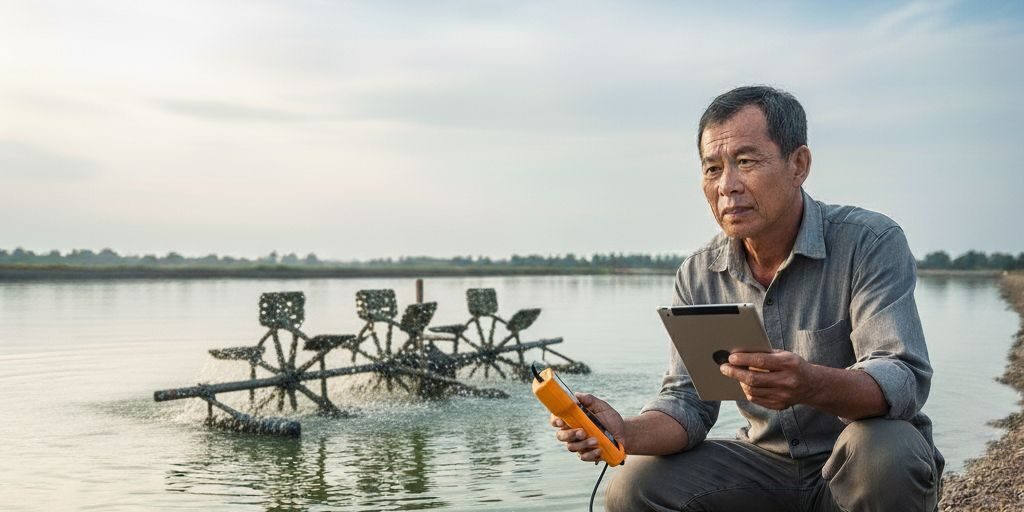- Software Gestor para Aquicultura
- (85) 2139-6730
- contato@despesca.com.br
Water Quality Continuous Monitoring: The Cost of Not Measuring

Beyond Raw Product Sales: How to Add Value to Your Product and Conquer New Markets
16/09/2025
Fish Consumption Trends 2025
18/09/2025The Cost of Not Measuring: How Much Do You Lose by Not Having Continuous Water Quality Monitoring?
In modern aquaculture, many costs are visible: feed, energy, labor. However, one of the biggest drains on profitability is invisible and silent: the neglect of water quality. Continuous monitoring of parameters is not a cost, but an investment with a direct return on animal health and, consequently, on your bottom line. Ignoring it means giving up control and leaving production to chance.
The success of a production cycle, whether in shrimp farming or fish farming, depends on a stable environment. The lack of water quality monitoring can turn a promising pond into a complete loss within hours. Closely tracking indicators is the only way to act preventively, rather than remediating already established losses.
Vital Parameters and Their Direct Impacts
Each water parameter functions as a vital sign for your cultivation. The absence of measurement prevents the producer from identifying problems before they become critical.
- Dissolved Oxygen (DO): Perhaps the most critical of all. Low DO levels, especially overnight, cause acute stress, reduce feed consumption, and can lead to massive mortalities. An animal struggling to breathe does not convert feed into growth.
- Ammonia and Nitrite: Toxic nitrogenous compounds, resulting from animal metabolism and organic matter decomposition. At high levels, they cause gill damage, reduce blood oxygen transport capacity, and open doors to opportunistic diseases.
- pH: pH instability directly affects the chemical balance of the water. Abrupt variations stress animals and can enhance ammonia toxicity, turning a controllable problem into a crisis.
- Temperature: Governs the metabolism of fish and shrimp. Fluctuations outside the ideal range decrease feeding activity and can compromise the immune system, delaying growth and increasing cycle time.
Quantifying Losses: The Damage of Missing Data
Not measuring has a real cost, which can be calculated through production indicators. The lack of an ideal environment generates a cascade of negative effects that directly impact financial results.
The first affected indicator is the Feed Conversion Ratio (FCR). Animals stressed by adverse water conditions eat less and poorly utilize feed nutrients. This means more feed is needed to achieve the same weight, directly increasing the primary production cost. Efficient feed management is directly linked to a quality aquatic environment. To learn more about optimizing this indicator, check out our article on the importance of feed conversion in shrimp and fish farming.
Furthermore, vulnerability to diseases increases exponentially in an unbalanced environment. Disease outbreaks are frequently linked to a primary stressor, such as an ammonia spike or an oxygen drop. Costs with medication, animal losses, and batch devaluation are direct damages. Prevention, based on data, is always cheaper than treatment.
From Manual Measurement to Smart Management with Software
The routine of measurements with colorimetric kits or multiparameter probes is a fundamental step. However, these data, when recorded on clipboards or loose spreadsheets, lose their greatest potential: trend analysis and correlation between events.
This is where a management software like Despesca becomes a strategic tool. By centralizing all water quality records, the system allows for:
- Viewing History: Identifying seasonal or critical hourly patterns for parameters like oxygen.
- Correlating Data: Understanding how specific feeding management impacts ammonia levels, for example.
- Making Informed Decisions: Adjusting aeration, feeding, or water renewal based on concrete data, not assumptions.
- Increasing Biosecurity: Rigorous monitoring is one of the pillars of aquaculture biosecurity, as it allows for early detection of imbalances that favor pathogens.
In summary, the cost of not measuring is the cost of uncertainty. It is the value of wasted feed, animals lost to diseases, and avoidable mortality. Continuous monitoring, combined with a management platform, transforms raw data into strategic information, ensuring shorter, healthier, and, above all, more profitable cycles.




